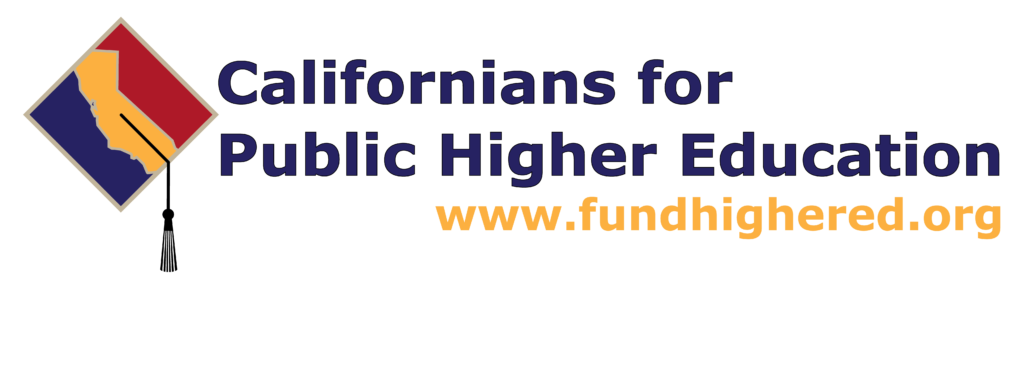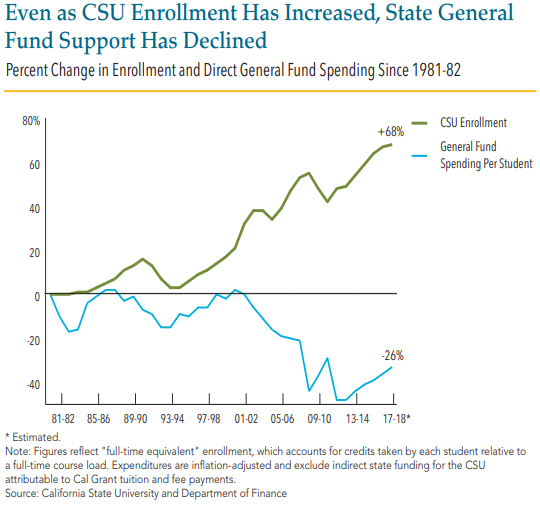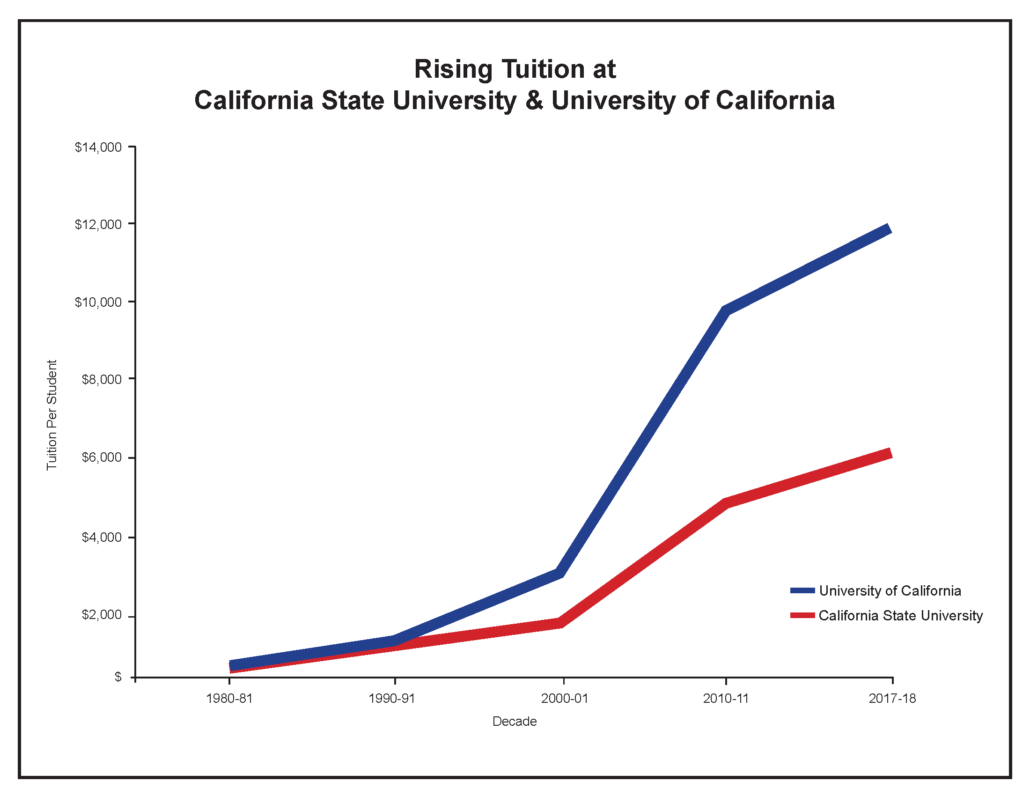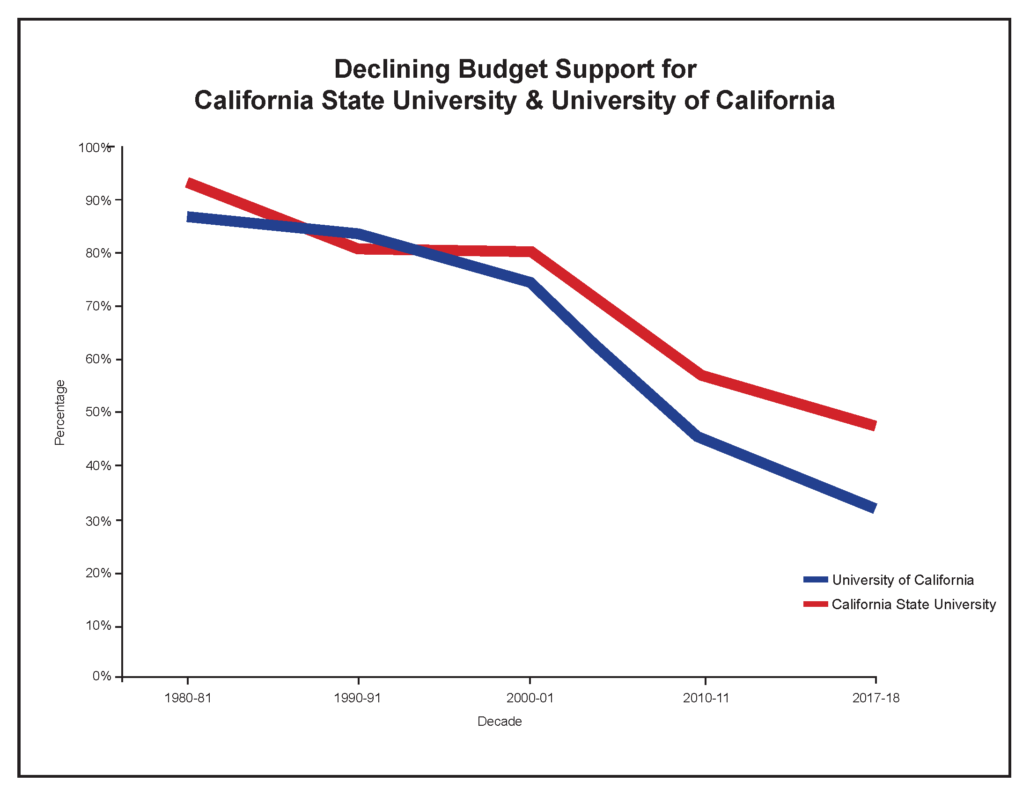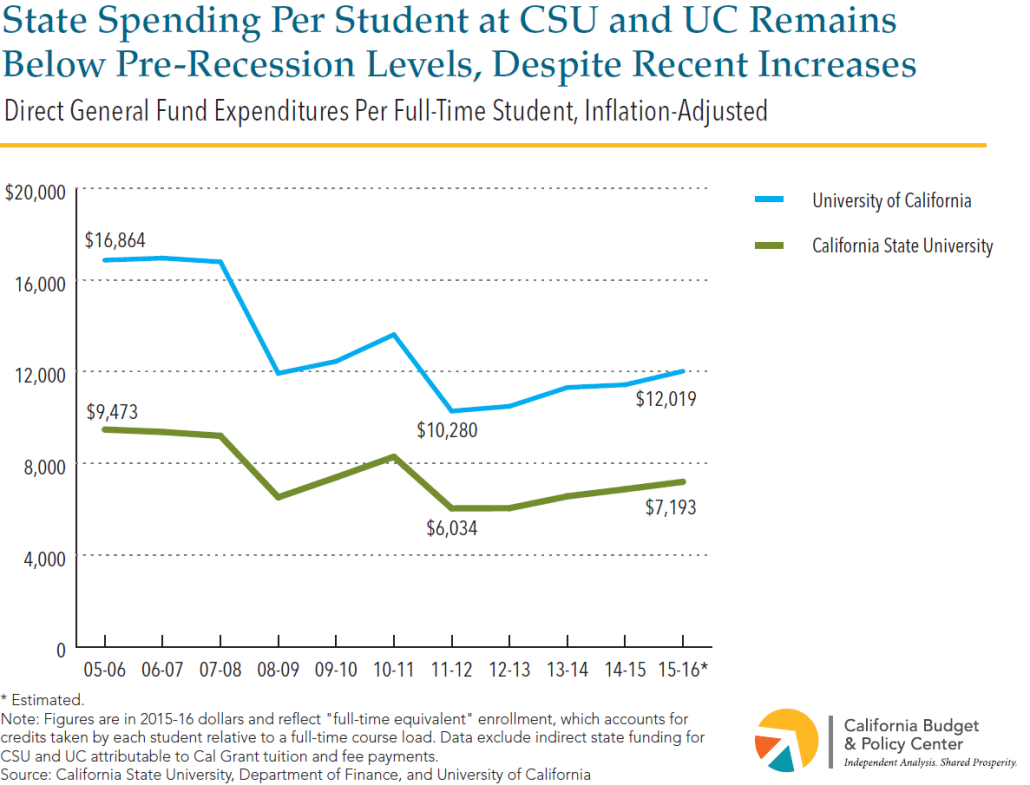On March 19, 2018, University of California President Janet Napolitano delivered a keynote address for Town Hall Los Angeles. Here’s a transcript:
“150 Years of Opportunity”
Thank you, George, for that introduction. It’s great to be back in LA, and at Town Hall. We’re very fortunate to have George as our Board Chair and to have his excellent leadership. In addition to UC’s Student Regent-Designate Devon Graves, UC Academic Senate Chair Shane White is here.
I’m also honored to welcome two very special students:
- Skylynn Hayes is a student at West Adams Preparatory High School, an LA Promise Fund partner school that I’ve had the privilege of visiting. Skylynn lost her father when she was young, and was raised by her single mother. She’s excelled academically at West Adams, earning a 3.9 GPA.
- I’d also like to recognize Adriana Argueta Balan [AH-DREE-ANA AR-GEH-TA BA-LAN] who is also here today. She, too, is a West Adams student, born and raised in Guatemala. When she arrived at West Adams, Adriana did not speak English. But she learned it quickly while holding a part-time job, and now she holds a 3.6 GPA!
Both Skylynn and Adriana have already been accepted to UC Davis and UC Merced, and await responses from some of our other campuses as well. I hope to see you both at one of UC’s campuses next fall. Now, let’s give these hard-working students, and all the students in the room, a round of applause!
Students like Skylynn and Adriana embody the spirit behind the University of California. This is a top-notch higher education institution that is accessible to all who work hard and qualify academically, regardless of their income or their background.
And that was the same vision Californians had in mind when they set out to build the University of California 150 years ago. Although they looked to institutions on the East Coast and in Europe for inspiration, they were intent on creating a different kind of university, one more accessible and egalitarian than Oxford or Yale.
The University of California has always been ahead of the curve when it comes to breaking barriers and expanding opportunity.
- Fifty years before American women secured the right to vote, the University of California was already admitting women. Eight of them attended classes at UC in that first year.
- And more than two decades before the U.S. Supreme Court ruled in favor of same-sex marriage, the University of California opened its first LGBT resource center – the first of its kind on any California campus.
Perhaps one of the most emblematic stories of UC’s approach to creating opportunity is the one about an African American boy raised in the projects of San Francisco.
Terry Allen was only 13 when he saw his oldest brother killed. And as he became more aware of the steep number of African American men who die young in this country, Terry began to wonder if he was next.
His parents sought to reassure him that education could be his ticket to safety. UC Berkeley was only 15 miles away from where Terry grew up. So, he applied for admission, was accepted, and he went on to graduate from Berkeley in 2013.
His college degree paved the way to a job at the White House as part of the Obama Administration. Terry recently wrote his first book, and launched a non-profit that helps under-developed communities achieve sustainability. Today, Terry is pursuing his Ph.D. and working as a course instructor at the UCLA Graduate School of Education and Information Studies.
Stories like Terry’s – of a UC education opening doors to a better future – define the University of California. They have shown us, time and again, that the opportunity to attend UC and earn a college degree can fundamentally change Californians’ lives, and they, in turn, change the lives of others still.
In the 150 years since the University of California was established, we have honored the original vision that makes these life-changing moments possible:
- Around its 50th year mark, the University expanded its footprint – and its ability to serve Californians of all walks of life – when the “Southern Branch” became an official UC campus. Today, we know that as UCLA. (Go, Bruins!)
- Near its 100th year mark, UC President Clark Kerr and several other education leaders embarked on an unprecedented effort to define the roles and responsibilities of California’s public higher education institutions. To this day, the Master Plan for Higher Education guides the direction of the University of California, the California State University system, and the California Community Colleges. And each of these three segments plays a critical role in ensuring Californians can access a top-quality, affordable higher education.
- Today, at its 150th year mark, UC is upholding the original vision of its founders in new and innovative ways: For example, the UC Scout program offers online Advanced Placement and “A-G” courses, enabling students in all corners of California to enroll in the classes they need to qualify for admission to either UC or Cal State. Meanwhile, the University’s partnership with historically black colleges and universities brings African American students to UC for internships during the summer, putting them on a path to pursue graduate education at one of our campuses.
This steadfast commitment to ensuring that every Californian has a shot at a UC education has resulted in remarkable social and economic mobility for the individual: Forty-two percent of UC undergraduates—forty-two percent!—are the first in their family to attend a four-year college or university. Half of them surpass the incomes of their parents by the time they’ve been out of school for five years.
Compared to other four-year colleges in California, UC also enrolls a larger share of students who come from the bottom 20 percent of income earners. For these students, a UC degree can level the playing field for decades to come: they go on to earn as much as students who come from higher income families. In most cases, those earnings double within 10 years of graduation.
This year is the University of California’s 150th anniversary—its sesquicentennial—so it’s natural to reminisce about these past accomplishments. And it’s tempting to look at the University’s stunning story of success and think that we can sit back and simply admire what California has achieved with its public research university system.
But rather than resting on our laurels, these accomplishments should spur us on to further action. Knowing how transformative a UC education can be – for the individual, and for society at large – it’s incumbent upon us to help more Californians become part of the opportunity story at the University of California.
And doing so is not easy. We have no special formula that will conjure up more funding, no silver bullet that can streamline the diversity pipeline, no quick or easy solution to any of the challenges we must overcome. But we do know that a UC education translates into a lifetime of opportunity.
So, this afternoon, I’d like to share with you three specific steps the University of California, in partnership with the State, can take to put a UC degree into the hands of more Californians.
The first step involves community college transfers.
Nearly one-third of UC’s undergraduates begin their higher education path at a community college. These students succeed at the same rate as those who arrive at the University as true freshmen, and they contribute to the diversity of experiences among our student body. Within a decade of completing their UC degrees, over half of those who transferred from a community college, and who work in California, are earning salaries that place them among the top third of income-earners in the state.
And their personal stories are very inspiring. Take Daniela Estrada, for example. Daniela is a UC Irvine political science major who graduated last June with honors, and was named both a Fulbright and a Truman scholar. Daniela was also a first-generation college student whose father was forced to quit school as a young child to pick tobacco in the fields of Mexico.
Early in my presidency, I made a commitment to increase the number of community college transfer students at UC. We have done so by collaborating closely with our counterparts at the California Community Colleges, and by working to simplify the transfer process.
Those efforts have paid off: in the fall of 2017, the University had 6,000 more California Community College transfer students enrolled at our campuses than we did in the fall of 2013, when I first arrived at the University.
But that doesn’t mean our work is done. We need to take it even further. So, earlier this month, I called on UC’s Academic Senate to determine what it will take to extend a guarantee of admission to all qualifying California Community College transfer students.
The guarantee can use the current 21 Transfer Pathways as a key building block. Successful completion of a Pathway, along with obtaining the requisite GPA, should entitle a community college student to a guaranteed place in the UC system. I have asked my colleagues in the Academic Senate to review proposals to facilitate transfer and transfer-preparation so that the guarantees are in place by the fall of 2019, at the outset of the University’s 151st academic year.
This would be a major leap for the University of California – one that must be implemented carefully to achieve its desired effect. I am committed to working closely with the California Community Colleges, and with UC’s own Academic Senate, and with all stakeholders to make sure we get this right.
Of course, many of UC’s undergraduates enroll as freshmen. In keeping with UC’s mission to serve Californians, the University has gone to great lengths to increase enrollment of California students over the past several years – without any new enrollment funding from the state.
Three years ago, we made a commitment to enroll an additional 10,000 California undergraduates by the 2018-19 academic year. I’m proud to report that we have already met that goal, and that today, more Californians study at the University of California than at any time in our history. Importantly, our undergraduate student body is ever more diverse: nearly one-third of the students who enrolled last fall come from historically under-represented minority groups, and they do extraordinarily well at UC.
Now, the push to increase enrollment of Californians comes, in part, because of the great demand for a UC education. Last year, the number of UC admission applications broke the record for the 13th straight year. That same demand also dictates that we do everything we can to help our current UC students graduate on time, and make room for the next cohort of undergraduates. And that’s where step two comes in.
This month, I called on UC’s Chancellors to explore how we can further streamline the degree pipeline, and ensure that at least 70 percent of our undergraduates graduate within four years.
Raising UC’s four-year graduation rate from its current 64 percent level would make room for more undergraduates, and generate an additional 32,000 undergraduate degrees between now and 2030—almost like adding an entirely new UC campus. Students will be able to reduce their college costs by moving more quickly into the workforce, or to graduate or professional school.
I believe we can meet this challenge by expanding access to online education courses, increasing UC’s summer session enrollment, encouraging more students to study abroad, and doubling-down on our student support services.
Once more, we will be conscientious in our approach. We will not diminish UC’s academic quality or our students’ ability to succeed by forcing a one-size-fits-all educational model. But we will push our University community to widen the definition of what a UC education can look like, and provide new ways for California students to earn their degrees in a timely manner.
This brings me to the third step UC and California must take together.
We’ve been told for some time that our state will soon face a significant shortage in college-educated residents. That’s a prospect that should concern every single Californian who cares about the state’s future. It demands that we grapple with a complex question: how do we help more Californians achieve the college education we know they need and want?
I have asked the State Legislature, and I will ask the next Governor of California, to work with UC and CSU to help answer that question. Together, we can tackle the college graduate gap, and make sure that our state is producing the educated workforce it needs for the decades ahead.
Our partners at the LA Promise Fund are also targeting the problem, and I applaud their efforts. Over the next several months, they will begin implementing a plan to help more students in the Los Angeles area earn college degrees. They will focus on expanding college access and persistence services, public communication efforts, and regional partnerships.
Now, the effort to address the degree gap will require close collaboration and careful planning on the part of the state’s public higher education segments. But it will also require a significant investment by the state to fund critical educational needs. UC is grateful for the state support we’ve received in recent years, following devastating budget cuts that occurred during the Great Recession. But we still do not have sufficient state support to pay for increases in enrollment, the necessary expansion of our campuses, or the growing needs of our students.
In fact, the University of California educates 90,000 more students today than we did in the year 2000, yet our state appropriation has remained basically the same. Put another way, if UC received the same per-student funding today as we did in 2000, our state appropriation would amount to more than $7 billion, instead of the $3.4 billion we currently receive. It’s a big gap.
This, too, should concern every single Californian. A vibrant University of California is essential to the upward trajectory of our state and its people. You’ve heard snippets today about graduates whose UC experience made it possible for them to accomplish incredible things. I’d like to close my remarks today with one last story. This one is about a Californian who credits his UC education not only with creating opportunities that changed his life, but with saving his life.
Frankie Guzman seemed to be headed for a life behind bars. He was raised in the poor, mostly immigrant community of East Oxnard, about 60 miles away from here. He endured his parents’ divorce and his family’s subsequent homelessness at the age of 3. By the time Frankie was 15, he was arrested for armed robbery, and, on his first offense, was sentenced to serve 15 years in the California Youth Authority.
Frankie was released on parole after six years served, and went on to attend Oxnard Community College. His education was interrupted when he was re-incarcerated twice, but he persisted with his studies, and he eventually gained admission to UC Berkeley. After graduating, he was accepted to the UCLA School of Law, and earned his law degree in 2012.
Today, Frankie Guzman works as an attorney for the National Center for Youth Law in Oakland, serving as Director of the California Juvenile Justice Initiative. He’s putting his personal experiences and his UC education to good use by working with state leaders to pass legislation to reform incarceration practices for juveniles. Earlier this year, he won the prestigious Juvenile Law Center’s Leadership Prize for his efforts.
When asked to reflect on his college education, Frankie summed it up simply: “I’d be in a dark place without it.”
Frankie’s journey illustrates what many of us already know well: that education is the great equalizer, and that the University of California is the ultimate opportunity-creator. And so, as our state grows more diverse, and as UC’s enrollment continues to increase, now is not the time to pull back on our investment in public higher education. Now is the time for Californians to double-down on their investment—to expand access to the University of California, and to sustain its academic quality.
When I last addressed a Town Hall Los Angeles audience almost three years ago, I said that all Californians have a voice—and a stake—in the public dialogue about the University of California. I argued that the focus of that dialogue ought to be on what we can do, together, to ensure that the University of California is an even greater public research university in the future than it has been in the past. Those words still hold true now—maybe more so today as we celebrate UC’s sesquicentennial, and consider what kind of public research university we want for California in the next century and a half.
Many of you have been champions for education and outspoken supporters of this university—including Antonia Hernandez of the California Community Foundation; Veronica Melvin of the LA Promise Fund; Michele Siqueiros of the Campaign for College Opportunity; Oscar Cruz of Families in Schools; and members of the California Coalition for Public Higher Education. I hope that when you leave here today, it will be with a renewed energy for this important advocacy work, a personal stake in the dialogue about UC’s future, and a lucid vision for how a UC education can open the doors of opportunity wide open for the next generation of Californians.
I believe the University of California is an institution worth investing in – and worth fighting for. UC is special—a daring public experiment that’s become a priceless public good. It belongs to all of us, and today, I ask that you join me in working to ensure that every Californian gets the opportunity to reap its extraordinary rewards.
Thank you! This is a great university, and the fight is on. So, let me close with the motto of the University of California, “Fiat Lux!” Or, “Let There Be Light!”
